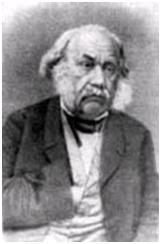Nicolai Stepanowitsch Turczaninow facts for kids
Quick facts for kids
Nicolai Stepanowitsch Turczaninow
|
|
|---|---|

Photo of Nikolai Turczaninow
|
|
| Born | 1796 Nikitovka, Russia
|
| Died | 1863 (aged 66–67) Kharkiv, Russia
|
| Nationality | Russia |
| Alma mater | University of Kharkiv |
| Known for | Flora Baikalensi-Dahurica |
| Awards | Demidov Prize (1857) |
| Scientific career | |
| Fields | Botany |
| Institutions | |
| Author abbrev. (botany) | Turcz. |
Nicolai Stepanowitsch Turczaninow (born 1796, died 1863) was a famous Russian botanist. A botanist is a scientist who studies plants. He was born in a town called Nikitovka, in the southern part of Russia, close to the city of Kharkiv in Ukraine.
Nicolai Turczaninow was the first to discover and name many different types of plants. Some plants have even been named after him! You might also see his name written as Nikolai Stepanovich Turchaninov or Nikolaus von Turczaninow.
Contents
Biography
Early life and education
Nicolai Turczaninow was born in 1796, probably in May. His birthplace was Nikitovka, which is now in the Belgorod region of Russia.
When he was 14, in 1810, he went to high school in the city of Voronezh. Later, he studied at the University of Kharkiv. After graduating in 1814, he moved to Saint Petersburg (St. Petersburg) to work for the government.
While working in St. Petersburg, Turczaninow spent his free time studying the plants around the city. In 1825, he published a list of 646 different plant species he had found there.
Exploring Siberia
In 1828, Turczaninow was sent to Irkutsk, a city in eastern Siberia, to work for the local government. This was a great chance for him to explore! In his free time, he traveled around the beautiful Lake Baikal area.
He collected many plants during his travels. He sent some of these plants to St. Petersburg and kept others for his own collection, called a herbarium. A herbarium is like a library of dried plants.
In 1830, he became a "Fellow" of the Imperial Botanical Garden in St. Petersburg. This allowed him to explore even more of Siberia, from the Altai Mountains all the way to the Pacific Ocean.
He collected plants not only around Lake Baikal but also in northern China and Mongolia. He sent the plants and seeds he found to the St. Petersburg Botanical Garden. He also kept copies for his own herbarium. From 1831 to 1834, Turczaninow wrote articles about the plants of Siberia and Mongolia.
In 1837, he moved further west to the town of Krasnoyarsk. He later became the Governor of that region. In Krasnoyarsk, Turczaninow started publishing his most famous work, Flora Baikalensi-Dahurica. This huge plant guide was published in parts from 1842 to 1857. He wrote it in Latin, a language often used for scientific names. Later, all these parts were put together into two books. The first part had an introduction written in French.
Later life in Kharkiv
After 17 years in Siberia, Turczaninow moved to Taganrog in 1845. This city is on the Sea of Azov, close to the Black Sea.
While in Taganrog, he had an accident and broke his leg. This injury stopped him from traveling to South America, which he had wanted to do. In 1847, Turczaninow moved to the city of Kharkiv. There, he worked in the herbarium at the University of Kharkiv.
Nicolai Turczaninow passed away in Kharkiv on December 26, 1863.
Honours and Legacy
Nicolai Turczaninow received many awards for his important work. In 1857, the Academy of Sciences in St. Petersburg gave him the Demidov Prize. This was a special award for his great contributions to the study of Russian plants. The University of Kharkiv also made him an honorary member.
Many plant species have been named after Turczaninow to honor him. Also, a scientific bulletin (a type of magazine) published by the Altai State University is called Turczaninowia. It is named after him to celebrate his lasting impact on botany.
Images for kids
See also
 In Spanish: Nikolai Turczaninow para niños
In Spanish: Nikolai Turczaninow para niños


